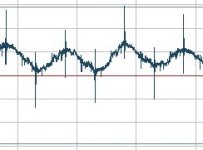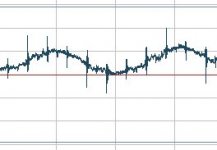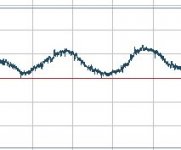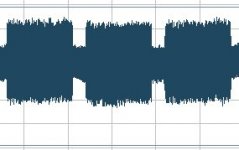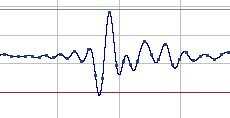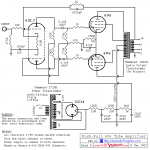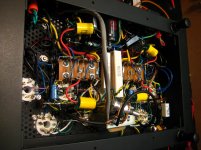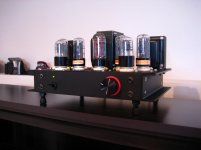These signals appear on the output of a tube phono preamp.
Input connected to phono cartridge at idle.
Power supply from 50Hz mains transformer, bridge rectifier, filter caps etc, 300 v, 20 mA.
Several problems where I am stuck:
1) Hum is 50 Hz, but should be 100 Hz if it came from power supply. Removing the PS and transformer far (one meter) from the already shielded amp helps to some extent, but not enough.
2) The nasty spikes. They come and go and I guess they do not originate in the amp itself. They vary over time (1) (2), may even disappear completely for some time (3). Or pulse with a steady rhythm (4). Detail analysis shows ringing at approx. 15 kHz (5).
I tried all sorts of filters, resistor/cap, different chokes, w/o any effect. How can I get rid of these spikes ?
3) To get this far I had to connect the amplifier ground and shield to earth. Otherwise with ground floating the hum was much worse and it also had a harsh snarl. The signal plot shows why, the hum is not a sinusoidal wave but completely distorted (6). Any idea why ? It's still 50Hz and not the expected 100Hz. And doesn't grounding the amp to earth and therby the secondary of the HV transformer defeat the safety idea of mains isolation ?
Input connected to phono cartridge at idle.
Power supply from 50Hz mains transformer, bridge rectifier, filter caps etc, 300 v, 20 mA.
Several problems where I am stuck:
1) Hum is 50 Hz, but should be 100 Hz if it came from power supply. Removing the PS and transformer far (one meter) from the already shielded amp helps to some extent, but not enough.
2) The nasty spikes. They come and go and I guess they do not originate in the amp itself. They vary over time (1) (2), may even disappear completely for some time (3). Or pulse with a steady rhythm (4). Detail analysis shows ringing at approx. 15 kHz (5).
I tried all sorts of filters, resistor/cap, different chokes, w/o any effect. How can I get rid of these spikes ?
3) To get this far I had to connect the amplifier ground and shield to earth. Otherwise with ground floating the hum was much worse and it also had a harsh snarl. The signal plot shows why, the hum is not a sinusoidal wave but completely distorted (6). Any idea why ? It's still 50Hz and not the expected 100Hz. And doesn't grounding the amp to earth and therby the secondary of the HV transformer defeat the safety idea of mains isolation ?
Attachments
Your problem is best described as: weird. And my stable datum when things get weird is to suspect and look for HF/VHF oscillations.
You tell us nothing about the pre's design/topology. If it uses any tube with more gM than a 12AX7, then oscillation is a major possibility - and I've even had all 12AX7 phono pre's oscillate.
What bandwidth is your scope? Tubes like the 6DJ8 will oscillate happily at 100MHz, and WE417s even higher, so seeing the oscillation directly may be a problem.
Grid stoppers on ALL grids, especially any CFs in the circuit would be a first step,if you haven't used them already.
An oscillating amp is normally very sensitive to hand position, moving closer/further away from a tube will change the output. And unexplained hum is almost ALWAYS VHF oscillation that somehow always manifests at your basic mains frequency.
Don't expect logic to work in these situations - been there and have the scars to prove it...
Regards, Allen
You tell us nothing about the pre's design/topology. If it uses any tube with more gM than a 12AX7, then oscillation is a major possibility - and I've even had all 12AX7 phono pre's oscillate.
What bandwidth is your scope? Tubes like the 6DJ8 will oscillate happily at 100MHz, and WE417s even higher, so seeing the oscillation directly may be a problem.
Grid stoppers on ALL grids, especially any CFs in the circuit would be a first step,if you haven't used them already.
An oscillating amp is normally very sensitive to hand position, moving closer/further away from a tube will change the output. And unexplained hum is almost ALWAYS VHF oscillation that somehow always manifests at your basic mains frequency.
Don't expect logic to work in these situations - been there and have the scars to prove it...
Regards, Allen
3-stage design, triodes have mu=20, but there is also a pentode mu(g2g1)=50.
All tubes have 1k grid-stoppers. Heating is DC. Tried lifting the filament to +50 v but to no avail. The pentode also has a 18 pF miller cap between plate and grid to fix open loop gain rolloff. Now that I talk about it - not shure what the voltage rating is, there could be 150 v across it, got to check this ...
Signal plots where actually done with PC sound card, for ease of presentation.
But sound, noise, hum, spikes do not depend on whether sound card is connected. Which is maybe also a little strange, with the PC sitting on a different wall outlet there should be a huge additional ground loop - but no effect ...
My scope is unfortunately a little out-of-date, good for AF only I suppose. You are right, I may not have seen HF oscillation. I am not shure whether I understand how HF can turn into 50Hz hum. But now that you mention it, I just had that experience with a tube power amp recently, where the hum disappeared magically once I had fixed the oscillation tendency, which manifested itself only when the input was left open, causing smoke signals from the zobel ;-)
The amp itself is inside a metal cage, and I have not noticed any hand sensitivity. However whith the turntable switched on, and before I put the stylus on a record, there is sometimes a crackling sound from the speakers when my hand is hovering over the record player. Thought this to be static ... maybe not ...
There are no female cinch sockets yet, just a pair of short shielded cable with male cinch plugs at the ends to connect to the turntable. When I leave them open, hum increases by an order of magnitude. If shorted hum is same as connected with player.
The PS is currently external as I am still experimenting. I moved it away from the amp until the hum didn't improve any more.
All tubes have 1k grid-stoppers. Heating is DC. Tried lifting the filament to +50 v but to no avail. The pentode also has a 18 pF miller cap between plate and grid to fix open loop gain rolloff. Now that I talk about it - not shure what the voltage rating is, there could be 150 v across it, got to check this ...
Signal plots where actually done with PC sound card, for ease of presentation.
But sound, noise, hum, spikes do not depend on whether sound card is connected. Which is maybe also a little strange, with the PC sitting on a different wall outlet there should be a huge additional ground loop - but no effect ...
My scope is unfortunately a little out-of-date, good for AF only I suppose. You are right, I may not have seen HF oscillation. I am not shure whether I understand how HF can turn into 50Hz hum. But now that you mention it, I just had that experience with a tube power amp recently, where the hum disappeared magically once I had fixed the oscillation tendency, which manifested itself only when the input was left open, causing smoke signals from the zobel ;-)
The amp itself is inside a metal cage, and I have not noticed any hand sensitivity. However whith the turntable switched on, and before I put the stylus on a record, there is sometimes a crackling sound from the speakers when my hand is hovering over the record player. Thought this to be static ... maybe not ...
There are no female cinch sockets yet, just a pair of short shielded cable with male cinch plugs at the ends to connect to the turntable. When I leave them open, hum increases by an order of magnitude. If shorted hum is same as connected with player.
The PS is currently external as I am still experimenting. I moved it away from the amp until the hum didn't improve any more.
Last edited:
3-stage design, triodes have mu=20, but there is also a pentode mu(g2g1)=50<<
I didn't mention mu, I mentioned gM (transconductance). What tubes are they? High gM tubes tend to be VHF tubes, who LOVE oscillation.
>>All tubes have 1k grid-stoppers<<<
Right at the tube socket, or at some distance from the socket? 1mm is OK, 5mm is too far!
>>The pentode also has a 18 pF miller cap between plate and grid to fix open loop gain rolloff. <<
Does this mean it's a NFB design? Then I'm sure you have oscillation. A schematic would help a lot.
>>You are right, I may not have seen HF oscillation. I am not shure whether I understand how HF can turn into 50Hz hum<<
I don't think anybody understands that, but I assure it it does.
>> But now that you mention it, I just had that experience with a tube power amp recently, where the hum disappeared magically once I had fixed the oscillation tendency, which manifested itself only when the input was left open, causing smoke signals from the zobel ;-)<<
Exactly.
>>The amp itself is inside a metal cage, and I have not noticed any hand sensitivity. However whith the turntable switched on, and before I put the stylus on a record, there is sometimes a crackling sound from the speakers when my hand is hovering over the record player. Thought this to be static ... maybe not ...<<
That sounds like static to me.
>>There are no female cinch sockets yet, just a pair of short shielded cable with male cinch plugs at the ends to connect to the turntable. When I leave them open, hum increases by an order of magnitude. If shorted hum is same as connected with player<<
Throughly investigate oscillation. But the other poster's suggestion to check your mains supply for serious noise is also valid. Maybe it's both...
Regards, Allen
Thank you for your contributions !
Transconductance is moderate, around 6 mA/V.
Regarding hum I will concentrate on oscillations.
Regarding spikes, I suspected from the beginnng that they are external and come from mains. Electric motor drive is possible, there are some in central heating and hot water supply.
But here's the catch: when I use isolation xfrmr, 50Hz hum is up, and excessive, distorted but no spikes; when I connect circuit ground to earth, i.e. protective ground from wall socket, thereby breach isolation, hum drops by an order of magnitude, takes sinusoidal shape ... but spikes appear.
Just tried to put another isolation xfrmr in front of everything, to no avail however.
Could it be that the spikes come in thru protective ground ???
If so, would there be a means to remove them by some sort of a filter ?
Transconductance is moderate, around 6 mA/V.
Regarding hum I will concentrate on oscillations.
Regarding spikes, I suspected from the beginnng that they are external and come from mains. Electric motor drive is possible, there are some in central heating and hot water supply.
But here's the catch: when I use isolation xfrmr, 50Hz hum is up, and excessive, distorted but no spikes; when I connect circuit ground to earth, i.e. protective ground from wall socket, thereby breach isolation, hum drops by an order of magnitude, takes sinusoidal shape ... but spikes appear.
Just tried to put another isolation xfrmr in front of everything, to no avail however.
Could it be that the spikes come in thru protective ground ???
If so, would there be a means to remove them by some sort of a filter ?
Sometimes hum is caused by oscillation because the oscillation draws so much current from the power supply that regulators drop out of regulation. If those DC heaters are regulated, it could be heater regulator oscillation. A circuit diagram would make it much easier to guess what the problem is.
What is the source of filament, AC or DC regulated? AC will make more hum/noise than DC regulated.
What about the filament and 0 - B+ connection, is filament source floating (doesn't connect to main supply)? If yes, try to give some 1/3 B+ to filament. If the topology is all AF, then it is safe to ground the filament supply.
I have the same problem and it solved by grounding/connecting the filament supply to either ground or some 1/3 B+.
Thx,
Ervin L
What about the filament and 0 - B+ connection, is filament source floating (doesn't connect to main supply)? If yes, try to give some 1/3 B+ to filament. If the topology is all AF, then it is safe to ground the filament supply.
I have the same problem and it solved by grounding/connecting the filament supply to either ground or some 1/3 B+.
Thx,
Ervin L
Made significant progress on the hum issue:
- shorter wires on output signals (!) inside the box
- re-routing of heater wires
- increased input voltage to heater DC regulator (not enough headroom for regulation I guess)
Further tampering with the heater (grounding or +50 v up) made things worse again ...
As it is now, I am pretty happy with 50Hz hum - or rather the absence of
I was even able to detect differences using tubes from different vendors when listening with headphones. There is still some residual hum when connected to my recenty finished tube amplifier, which is other wise hum-free, but that's a different story.
The peculiar spikes are still present from time-to-time, but almost certainly originate from the mains line. So far I could do nothing to filter / eliminate them. Made some experiments to shunt them to protective ground or so - but to no avail. Maybe safety ground is contaminated as well ...
Many thanks for your discussions. If somebody had an idea how to deal with such spikes - other than moving to a different house or town - would be still welcome.
- shorter wires on output signals (!) inside the box
- re-routing of heater wires
- increased input voltage to heater DC regulator (not enough headroom for regulation I guess)
Further tampering with the heater (grounding or +50 v up) made things worse again ...
As it is now, I am pretty happy with 50Hz hum - or rather the absence of
I was even able to detect differences using tubes from different vendors when listening with headphones. There is still some residual hum when connected to my recenty finished tube amplifier, which is other wise hum-free, but that's a different story.
The peculiar spikes are still present from time-to-time, but almost certainly originate from the mains line. So far I could do nothing to filter / eliminate them. Made some experiments to shunt them to protective ground or so - but to no avail. Maybe safety ground is contaminated as well ...
Many thanks for your discussions. If somebody had an idea how to deal with such spikes - other than moving to a different house or town - would be still welcome.
The peculiar spikes are still present from time-to-time, but almost certainly originate from the mains line. So far I could do nothing to filter / eliminate them. Made some experiments to shunt them to protective ground or so - but to no avail. Maybe safety ground is contaminated as well ...
Many thanks for your discussions. If somebody had an idea how to deal with such spikes - other than moving to a different house or town - would be still welcome.
I once was hired to fix a noise problem in a disco. Found +/- 600V spikes on the mains line! Called the electricity supplier, and they immediately sent a guy around to check, while I was still there. He verified my findings, and believe it or not, he (rather freaked out) called back to base and they shut down whole streets until the spikes stopped.
With the street identified (it was three streets away), he went door to door till he found the culprit - a huge fan in a basement warehouse with massive sparks flying off the brushes! With that forcibly off, the noise was gone.
They were worried the spikes would cause damage to expensive computer stuff, and they'd get sued, so were looking fast.
I'd call your supplier...
Regards, Allen
120 Hz spikes
Have just had this same problem; spikes at 60 Hz and 120 Hz riding on low level 120Hz from power supply of tube amp. Discovered that this noise was being generated by the dimmers in my rec room. Turned off dimmer - noise spikes gone. Thanks to this post for pointing me in the right direction.
Have just had this same problem; spikes at 60 Hz and 120 Hz riding on low level 120Hz from power supply of tube amp. Discovered that this noise was being generated by the dimmers in my rec room. Turned off dimmer - noise spikes gone. Thanks to this post for pointing me in the right direction.
Thanks.
Hi gootee and hpeter:
Thanks for your replies.
Have used twisted heater wires from the start of build - also tested with 6 volts DC via gel cell battery; no change in hum, so I'm thinking my hum is not from filament supply. CT of filmament in this design is not grounded - tried that but it added hum. Filament voltage floats happily at about 60 volts.
Have now twisted cathode grid taps from OPT and temporarily changed postion of my 1.5H choke. Was able to reduce 120Hz hum on output from about 11mV to about 5mV. Also shielded input to 6V6 in push-pull pair.
Schematic attached; my changes:
-10K feedback resistor instead of incorrect 1K that is shown,
- 100K stereo pot at input. I am feeding this amp directly from my CD player.
- 220R 25W power resistor at output (pin 8) of GZ34 instead of 100R that is shown on schematic, then the 1.5H Hammond Choke (Model 156R - 200mA, 56 ohms) in place of the second 100R resistor in the B+ RC Filter - so now an LC filter. Added additional 47uF cap parallel to second 47uF cap.
B+ of 320 Volts has 220mV of 120Hz Ripple. Second B+ (C+ ?) has only about 4mV of ripple on top of the 318V that is present at top of 22uF filter cap. I'm thinking this is a reasonable amount of ripple in both cases, especially as the 320V B+ feed the center tap of the push-pull OPT ? What are your thoughts ?
- Is 5mV of 120Hz hum at the speakers typical for this type of design ? I only actually hear it if I place my ear about 12 inches from the speaker. I am using high efficiency Paradigm Titan Monitor v.6 speakers. No hum or noise at normal listening distance...but the hum still bugs me !
- Attached interior photo of amp taken a couple of weeks ago with volume control pulled out, but gives you an idea of the density of the components in this build. Will allow more space in the next project... interior dimensions are 10" x 8". A bit tight.
Bill.
Hi gootee and hpeter:
Thanks for your replies.
Have used twisted heater wires from the start of build - also tested with 6 volts DC via gel cell battery; no change in hum, so I'm thinking my hum is not from filament supply. CT of filmament in this design is not grounded - tried that but it added hum. Filament voltage floats happily at about 60 volts.
Have now twisted cathode grid taps from OPT and temporarily changed postion of my 1.5H choke. Was able to reduce 120Hz hum on output from about 11mV to about 5mV. Also shielded input to 6V6 in push-pull pair.
Schematic attached; my changes:
-10K feedback resistor instead of incorrect 1K that is shown,
- 100K stereo pot at input. I am feeding this amp directly from my CD player.
- 220R 25W power resistor at output (pin 8) of GZ34 instead of 100R that is shown on schematic, then the 1.5H Hammond Choke (Model 156R - 200mA, 56 ohms) in place of the second 100R resistor in the B+ RC Filter - so now an LC filter. Added additional 47uF cap parallel to second 47uF cap.
B+ of 320 Volts has 220mV of 120Hz Ripple. Second B+ (C+ ?) has only about 4mV of ripple on top of the 318V that is present at top of 22uF filter cap. I'm thinking this is a reasonable amount of ripple in both cases, especially as the 320V B+ feed the center tap of the push-pull OPT ? What are your thoughts ?
- Is 5mV of 120Hz hum at the speakers typical for this type of design ? I only actually hear it if I place my ear about 12 inches from the speaker. I am using high efficiency Paradigm Titan Monitor v.6 speakers. No hum or noise at normal listening distance...but the hum still bugs me !
- Attached interior photo of amp taken a couple of weeks ago with volume control pulled out, but gives you an idea of the density of the components in this build. Will allow more space in the next project... interior dimensions are 10" x 8". A bit tight.
Bill.
Attachments
That resistor also provides cathode bias for the input stage/PS. If the input stage is running at low gain then there is less NFB to reduce hum.wboehlen said:10K feedback resistor instead of incorrect 1K that is shown
No CRTs in the house. Did also turn off all other electronics in the house when testing.
Will temporarily try SS rectifiers and larger filter cap and see what happens...
Will also try reducing NFB resistor to 5k or 6k.
Thank you all for the feedback. (And none of it is negative !)
Bill.
Will temporarily try SS rectifiers and larger filter cap and see what happens...
Will also try reducing NFB resistor to 5k or 6k.
Thank you all for the feedback. (And none of it is negative !)
Bill.
- Status
- This old topic is closed. If you want to reopen this topic, contact a moderator using the "Report Post" button.
- Home
- Amplifiers
- Tubes / Valves
- Preamp nasty noise and hum
